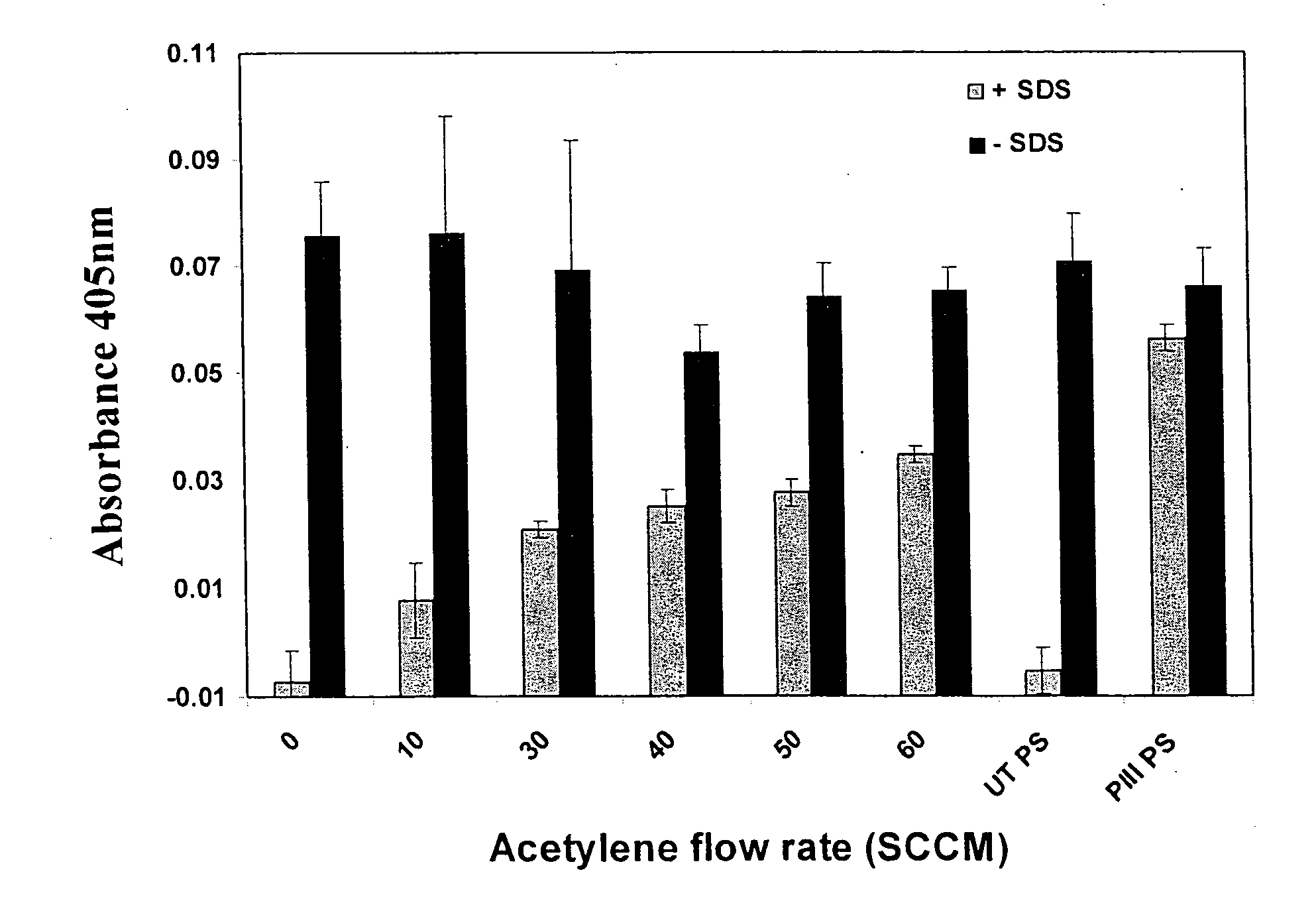Biological functionalisation of substrates
a biological functional and substrate technology, applied in the field of active substrates, can solve the problems of low adhesion, low conformation and therefore functionality, and variability in the degree of attachment, so as to improve surface stabilisation, maintain conformation and therefore functionality, and delay hydrophobic recovery
- Summary
- Abstract
- Description
- Claims
- Application Information
AI Technical Summary
Benefits of technology
Problems solved by technology
Method used
Image
Examples
example 1
Plasma Treatment of Metal, Semiconductor, Polymer, Composite and Ceramic Substrates for Enhanced Binding of Functional Horseradish Peroxidase
Materials and Methods
[0098]FIG. 1 shows a schematic of the plasma treatment chamber. The source region consists of two parallel electrodes. Radio frequency power at 13.56 MHz or high voltage pulsed power is coupled to the electrodes by a Comdel CPM-2000 matching network or ANSTO PI3 power supply, respectively. The sample is mounted on the powered electrode the other electrode is connected to earth. The base pressure of the chamber is around 3×10−6 torr.
[0099]Acetylene and argon were admitted to the chamber at flow rates of 1.5 sccm and 5 sccm respectively, to a pressure of 150 mT. The unit sccm indicates a flow unit of one standard cubic centimetre per minute. The pulsed power supply is connected and the technique of Plasma Immersion Ion Implantation and Deposition (PIII&D) is used with conditions of 1.5 kV, 10,000 Hz at a 10 μs pulse length. S...
example 2
Plasma Treatment of Substrates for Enhanced Binding of Functional Catalase
Materials and Methods
[0113]The materials and methods adopted are the same as for Example 1, but with the exception that instead of HRP, plasma treated polymer surfaces are incubated with the enzyme catalase (Sigma cat. no. C3155). An assay using surface exposure to hydrogen peroxide containing solution is then conducted according to the method of Cohen et al2, as hydrogen peroxide is consumed in a reaction catalysed by catalase, to determine catalase functionality. The surface is incubated with 6 mM H2O2 and allowed to react for 6 minutes on an ELISA plate shaker, before an aliquot is taken and measured for remaining hydrogen peroxide. The remaining H2O2 is measured by adding excess ferrous ions, which are converted to ferric ions. Ferric ions are then reacted with thiocyanate to form a reddish / orange coloured complex which absorbs at a wavelength of 475 nm. The optical density at this wavelength thus provides...
example 3
Effect of Tween 20 on Functional Attachment of Catalase to Plasma Treated Substrate
Materials and Methods
[0116]Catalase (Bovine liver catalase (EC 1.11.1.6) (C-3155, 20 mg / ml)) is attached to two sets of activated substrate surfaces using the same approach as for Example 2. One set of surfaces is treated with 10 mM PO4 0.005% Tween 20 (from BDH) for one hour whereas the other set is not treated with Tween 20. Catalase in 10 mM PO4, 0.005% Tween 20 pH 7 is then added to both sets of surfaces and incubated overnight with rocking. Samples are then washed as in Example 1 with 10 mM PO4 pH 7 buffer. No Tween 20 is included in the washing steps.
Results and Discussion
[0117]Detergents have long been used in ELISA assays for blocking areas of plasma polymer surface not coated with bound antigen and for washing off loosely bound antigens, antibodies and reagents. In particular, non-ionic Tween 20 detergent has been widely used because it permanently blocks a surface and does not appear to affe...
PUM
| Property | Measurement | Unit |
|---|---|---|
| Thickness | aaaaa | aaaaa |
| Thickness | aaaaa | aaaaa |
| Nanoscale particle size | aaaaa | aaaaa |
Abstract
Description
Claims
Application Information
 Login to View More
Login to View More - R&D
- Intellectual Property
- Life Sciences
- Materials
- Tech Scout
- Unparalleled Data Quality
- Higher Quality Content
- 60% Fewer Hallucinations
Browse by: Latest US Patents, China's latest patents, Technical Efficacy Thesaurus, Application Domain, Technology Topic, Popular Technical Reports.
© 2025 PatSnap. All rights reserved.Legal|Privacy policy|Modern Slavery Act Transparency Statement|Sitemap|About US| Contact US: help@patsnap.com



